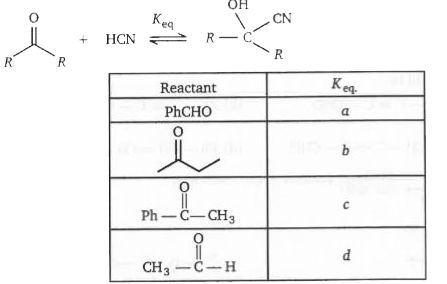If Eɵcell for a given reaction is negative, which gives the correct relationships for the values of ΔGɵ and Keq?
ΔG∘>0,Keq<1
ΔG∘>0,Keq>1
ΔG∘<0,Keq>1
ΔG∘<0,Keq<1
The correct Answer is:A
To solve the problem, we need to analyze the relationships between the standard cell potential (E∘cell), the standard Gibbs free energy change (ΔG∘), and the equilibrium constant (Keq).
1. Understanding the Relationship Between E∘cell and ΔG∘:
The relationship between the standard cell potential and the standard Gibbs free energy change is given by the equation:
ΔG∘=−nFE∘cell
where:
- n = number of moles of electrons transferred in the reaction
- F = Faraday's constant (approximately 96500 C/mol)
2. Analyzing the Sign of E∘cell:
Since it is given that E∘cell is negative, we can substitute this into the equation:
ΔG∘=−nF(E∘cell)<0
This implies that ΔG∘ will be greater than 0 (positive) because multiplying a negative E∘cell by −nF (which is positive) results in a positive ΔG∘.
3. Understanding the Relationship Between ΔG∘ and Keq:
The relationship between the standard Gibbs free energy change and the equilibrium constant is given by:
ΔG∘=−RTlnKeq
where:
- R = universal gas constant
- T = temperature in Kelvin
4. Analyzing the Sign of Keq:
Since we have established that ΔG∘>0, we can rearrange the equation:
Keq=e−ΔG∘/RT
Because ΔG∘ is positive, −ΔG∘/RT will be negative, which means:
Keq<1
5. Conclusion:
From the analysis, we conclude that if E∘cell is negative, then:
- ΔG∘>0 (positive)
- Keq<1
Final Answer:
The correct relationships are:
- ΔG∘>0
- Keq<1
The relationship between the standard cell potential and the standard Gibbs free energy change is given by the equation:
ΔG∘=−nFE∘cell
where:
- n = number of moles of electrons transferred in the reaction
- F = Faraday's constant (approximately 96500 C/mol)
Since it is given that E∘cell is negative, we can substitute this into the equation:
ΔG∘=−nF(E∘cell)<0
This implies that ΔG∘ will be greater than 0 (positive) because multiplying a negative E∘cell by −nF (which is positive) results in a positive ΔG∘.
The relationship between the standard Gibbs free energy change and the equilibrium constant is given by:
ΔG∘=−RTlnKeq
where:
- R = universal gas constant
- T = temperature in Kelvin
Since we have established that ΔG∘>0, we can rearrange the equation:
Keq=e−ΔG∘/RT
Because ΔG∘ is positive, −ΔG∘/RT will be negative, which means:
Keq<1
From the analysis, we conclude that if E∘cell is negative, then:
- ΔG∘>0 (positive)
- Keq<1
The correct relationships are:
- ΔG∘>0
- Keq<1
Similar Questions
If the E∘cell for a given reaction has a negative value, then which of the following gives the correct relationships for the values of ΔG0 and Keq-
View SolutionIf the E∘cell for a given reaction has a positive value, then
which of the following gives the correct relationship for the values
of ΔG∘ and Keq :-
View Solution
Knowledge Check
Which is the correct relationship between ΔG∘ and equilibrium constant Kp?
Aa. Kp=−RTlogΔG∘Bb. Kp=[E/RT]ΔG∘Cc. Kp=−ΔG∘/RTDd. Kp=e−ΔG∘/RTFor a reversible reaction at 298 K the equilibrium constant K is 200. What is value of ΔG∘ at 298 K ?
Aa. −13.13kcalBb.-0.13kcalCc. −3.158kcalDd. −0.413kcal
The correct order of decreasing value of Keq is :Aa>b>c>dBd>a>b>cCd>b>a>cDd>a>c>d
Which reaction has positive value of ΔG∘?
View SolutionWhich is not correct relationship between ΔGΘ and equilibrium constant KP.
View SolutionA large positive value of ΔGɵ corresponds to which of these?
View SolutionAssertion (A) : Poistive catalysts increase the rate of reaction.
Reason (R ): Catalysts decrease the value of ΔGɵ.
View SolutionWhich is the correct order of size ?
(Oɵ,O2−,FɵandF)
View Solution
